市场资讯及洞察
.jpg)
摘要
IEA 最新月报显示,全球石油需求增速放缓但仍具韧性。尽管库存持续回升,但 OECD 库存整体仍低于五年均值,市场对供应中断高度敏感。OPEC、IEA、EIA 均上调非 OPEC 供应,未来可能出现“松中带紧”的供需结构。原油价格在供应宽松预期与地缘扰动之间反复震荡,波动率下降但敏感度上升。油市表现也可能通过风险偏好外溢至能源板块、商品货币及相关市场。
一、全球原油供需前景:IEA 月报核心要点
国际能源署(IEA)最新原油月报显示,全球石油需求虽较去年降温,但整体依旧保持韧性 [1]。先进经济体消费表现好于预期,有效抵消部分新兴市场的疲弱需求。IEA 预计 2025–2026 年全球石油需求将保持温和增长。然而在供应方面,如果 OPEC+ 维持当前产量政策且需求不出现明显下滑,全球石油市场未来数个季度可能重新进入“边际紧平衡”状态。IEA 同时指出,高油价、全球经济放缓、电动车渗透等因素正在逐步压制需求增速,使油市呈现出“短期紧平衡、长期温和宽松”的结构。
二、多机构观点对比:OPEC、EIA 与 OECD 数据
三大机构对于未来市场平衡的看法存在显著差异,这主要源于对非 OPEC+ 供应增长和需求韧性的不同假设。总体来看,市场普遍认同未来供应将更加充裕,但对于过剩的规模和时间点存在分歧。

图 3:三大机构对 2025-2026 年需求与供应增长的预测对比,显示供应增长普遍超过需求增长,预示市场将进入供应过剩周期。
OPEC 的观点相对乐观。OPEC 预计 2025 年全球石油需求将增长约 130 万桶/日,2026 年略高至 140 万桶/日 [2]。与此同时,OPEC 在最新报告中连续上调非 OPEC 供给预期,并首次将 2026 年市场从“短缺”调整为“小幅过剩”,反映其判断未来供应增长可能快于需求。
EIA 的判断更偏向供应充裕。EIA 上调了美国页岩油产量预测,指出 2025 年美国原油产量将创历史新高。同时,全球供应预期被上调至日均 1.06 亿桶,高于全球消费的 1.041 亿桶,意味着未来库存可能持续累积 [3]。EIA 预期 2025–2026 年库存增加将对油价形成中期压力。
OECD 库存虽然持续回升,但仍低于五年均值。IEA 数据显示,今年全球观测库存前八个月净增约 2 亿桶,但 OECD 商业库存仍比五年均值低约 6700 万桶。整体来看,库存虽然恢复,但仍处历史偏低区间,使油市对供应中断的敏感度依旧很高。
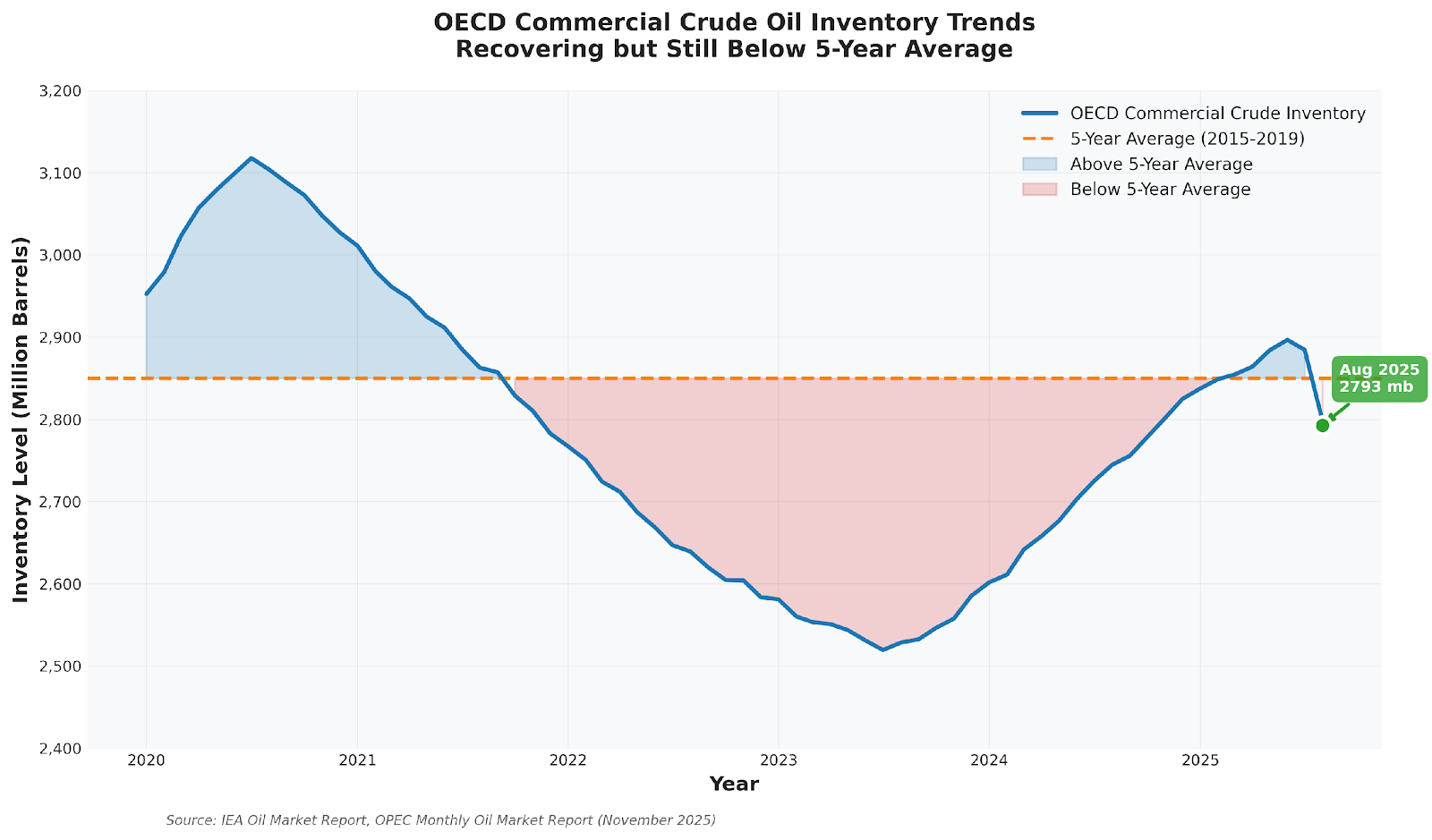
图 1:OECD 商业原油库存近 5 年对比最新水平,显示库存虽有回升但仍低于五年均值。
三、原油价格走势:WTI 与 Brent 如何消化预期
2023 年下半年,布伦特因供应紧张和地缘冲突预期一度突破每桶 90 美元。然而进入 2024–2025 年,随着供应回升和库存恢复,油价整体震荡下移。近期价格承压主要来自供应过剩预期强化以及美国库存意外上升。
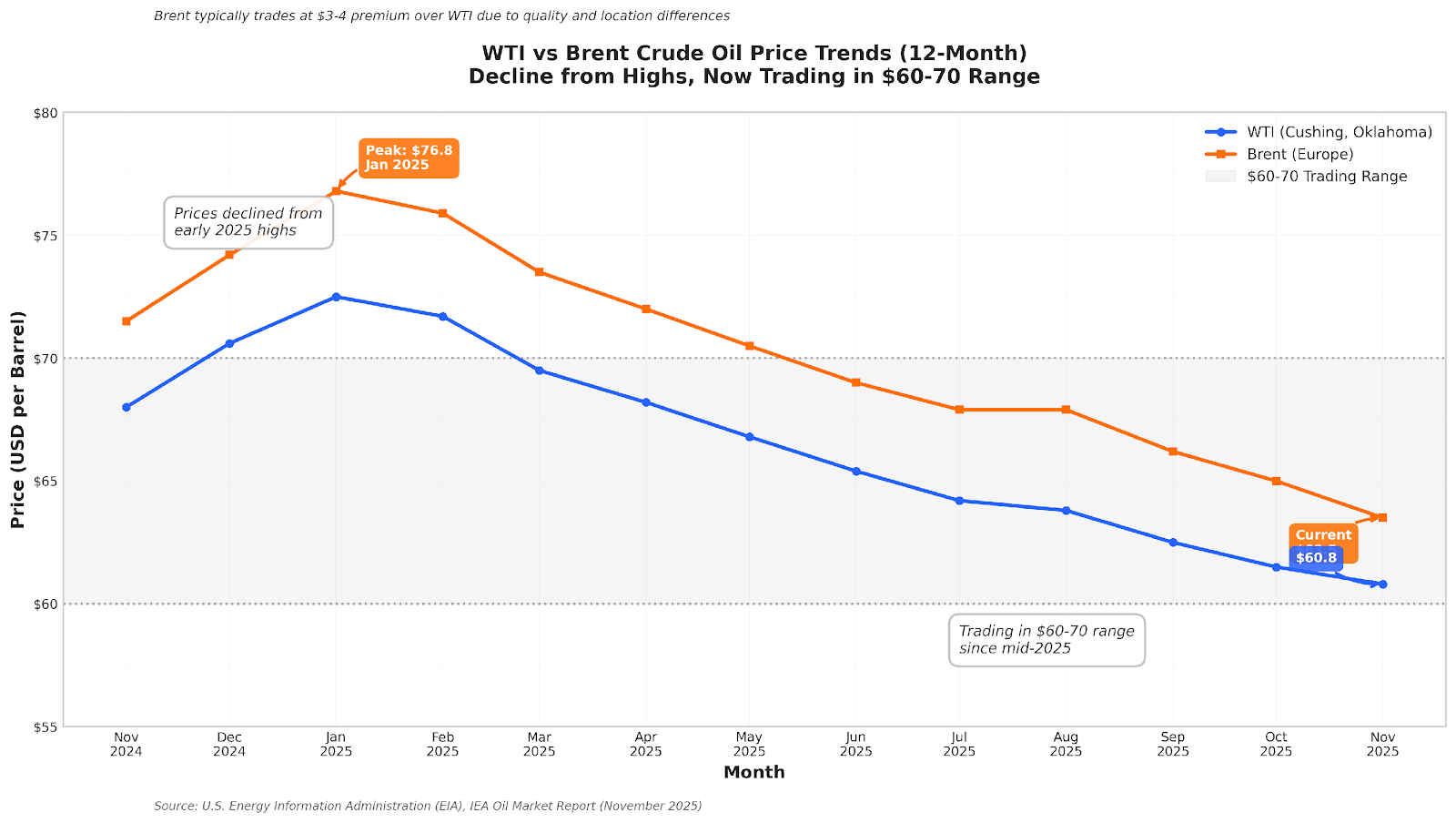
图 2:WTI 与 Brent 价格从 2025 年初的高位回落,近期在 60–70 美元区间震荡。
尽管地缘事件偶尔推升价格,但反弹难以持续,因为供应宽松的结构性预期迅速重新主导市场。WTI 与 Brent 的期限结构一度出现小幅 Contango,显示短期供应充裕压制近端价格,而远月因长期需求预期而保持相对坚挺。整体来看,油市呈现低波动、弱趋势但对消息高度敏感的特征。
四、驱动油市的关键变量:地缘政治与供应端不确定性
运输通道风险仍是油市最大的潜在冲击点之一。全球三分之一海运原油经过霍尔木兹海峡,一旦受阻便可能引发油价剧烈波动。衍生品定价显示断供概率虽低,但属于典型的“低概率、高冲击”事件。
OPEC+ 的政策滞后性也带来结构性波动。减产会压低库存、推高价格,但高油价又刺激非 OPEC 增产,使市场重新宽松。美国页岩油增速放缓进一步加剧供应端的不确定性,削弱其作为“摇摆产能”的角色。此外,俄罗斯、伊朗等国因制裁和冲突导致出口波动,更加剧油市敏感性。
五、油市变化的外溢影响
能源板块通常与油价同方向变动,但反应速度较油价更平缓。油价对风险偏好的溢出效应也容易影响澳元等商品货币。大宗商品价格上行往往提升商品出口国的贸易条件与风险情绪,而价格下跌则可能压制相关货币表现。
六、原油市场风险提示
- 数据发布风险: EIA 每周库存、IEA 与 OPEC 月报可能导致短线波动。
- 地缘政治风险: 产油区冲突、海运通道中断、制裁变化均可能影响供需平衡。
- 宏观风险: 利率政策、美元走势及全球经济增速变化都可能改变需求前景。
结语
IEA 最新展望显示,全球油市进入“边际紧平衡”阶段:库存修复但仍偏低,供应端不确定性大于需求端。在这种结构性环境下,油市会对政策、地缘事件与供给变化表现出高度敏感。理解供需框架、关注库存趋势与识别关键风险,将是未来判断油市走向的关键。
参考资料
[1] IEA (International Energy Agency). (2025, October). Oil Market Report - October 2025. https://www.iea.org/reports/oil-market-report-october-2025
[2] OPEC (Organization of the Petroleum Exporting Countries). (2025, November). Monthly Oil Market Report. https://publications.opec.org/momr
[3] EIA (U.S. Energy Information Administration). (2025, November). Short-Term Energy Outlook. https://www.eia.gov/outlooks/steo/
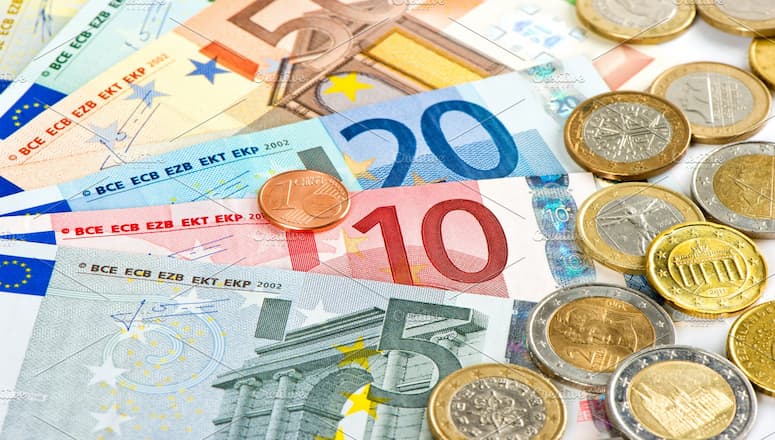

The EUR has been rebounding strongly on the back of being sold off for much of the year. With inflation at record highs and a cost of living and energy crisis, the currency has become extremely weak, even dropping below parity with the USD. However, in recent week, the EUR has begun putting in a bottom.
The ECB last night decided to raise their official rate by 75 bps. which along with a dovish statement caused a sharp drop in the EUR. On the weekly chart, the price has largely been in long term range with some exceptions relating to large economic events. Although, the price has been known to spike at various stages of economic volatility.
The chart shows that the price has been quite choppy between the range of 1.4000- 1.8500. The daily chart shows a potential double bottom that has been forming. The two bottoms are near 1.5700 and the neckline at approximately 1.7000.
The price already broke through the neckline and is nearly ready to retest the area as support. If the price can bounce off the neckline, it may have a primary target at 1.80, and then a secondary target of 1.8500. Waiting for ether a strong rejection candle or a consolidation near the neckline may provide a significant risk reward of near 3.5 or higher.
With inflation data the ECB still providing important information there may be some headwinds for the EUR as the region continues to deal with inflation.


Stop loss hunting is frustrating, annoying and can be detrimental to any retail trader. The premise of stop hunting is that large systemised institutional trading strategies know where the average retail trader or most traders will set stop losses and therefore profit off triggering these ‘stops. Their own algorithm will then deliberately, trigger the stop losses.
For traders there are few things as frustrating as have a well-positioned trade, being stopped out and then watching the price reverse in their original direction of the trade. What is a stop loss? Understanding stop loss hunting requires a simple understanding of what a stop loss is.
A stop loss is a trigger on traders’ position to close the position at a certain price. Generally, once triggered the position will attempt to be closed at the specified price. Stop losses provide an important role in risk management for many traders.
Generally, traders use stops losses to avoid emotional mismanagement and better manage overall risk by having clear exit points for the trade in worst case scenarios. The second element that is important to understand is where traders put their stop losses and why. Retail traders often place their stop losses near important market structures also known as support and resistance levels.
These areas represent strong zones of supply and demand. When support and resistance zones become more and more consistent and more obvious, it can create a clump of stop losses. These stop losses can be thought of as orders that must get filled if the price reaches those points.
This creates an attractive opportunity for large institutions with powerful algorithms that can push the price down and generate profits by ‘stopping out’ traders by triggering these stop losses. Once this process has occurred, the price will often move back in the direction the original trades were positioned for. Why would a system want to trigger stop losses Firstly, when stop losses are triggered, a price tends to see an increase in relative volatility.
Therefore, it may indicate the beginning of a reversal which sophisticated traders profiting. It also allows these large institutions to maximise their own existing trades as it may allow for better entries. Common areas for where stop hunters will look Stop Loss hunting tends to be most active around significant and clear areas of support and resistance.
This is especially true with regards to commonly traded assets. However, stop loss hunting can occur in all assets with various sizes. A stop hunt can be seen often with a small candlestick and a large wick.
In addition, they often occur on very short time frames. Common Area for Stop Loss Hunting At key moving average levels Clear Support and Resistance Levels Historical Support and Resistance Levels ie, Multiyear levels How to deal with Stop Loss Hunting? The obvious tactic to deal with stop hunting is to lower the stop loss below the obvious support and resistance level by a factor of maybe 10%.
This may require smaller trade size, but overall will allow the trade to hopefully avoid these potential stop losses. Treat support and resistance as areas instead of specific price points. Support and resistance do not exist at one price and rather a range of prices that are supply and demand zones.
Therefore, placing stop losses below these 'zones' may put the trade out of arm length of stop hunters. Simply being aware of stop loss hunting may provide some reassurance when a sharp spike in price occurs, to remain in the trade and not exit immediately. Ultimately, Stop Loss Hunting is just another challenge that traders must deal with in the pursuit of profit.
However, with some knowledge traders can adequately accommodate these tricky occurrences.


热门话题
Liontown Resources 是一家电池材料勘探和开发公司,专注于在澳大利亚开发伟晶岩锂矿床,旗下核心资产为Kathleen Valley锂钽项目和Buldania锂项目。LTR目前市值近40亿,52周股价区间从最低的$0.875至最高$2.19,自股市入熊后并没有出现趴在低位的情况,属于跑赢了大盘的一类股票。
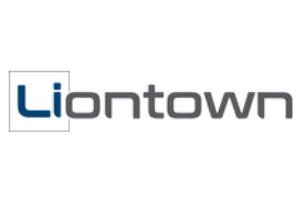
在进入10月后,随着公司消息面的不断利好,股价已经稳步上行,回到了年初的高位平台。从LTR手上的合同可以看出,公司将在2024年二季度投产,除了与特斯拉的限制性合同,公司还有LG的五年承购协议,以及跟福特的限制性承购协议和融资方案,公司最近还跟Zenith签署了电力供应合作合同。

项目
Kathleen Valley锂钽项目是一项LTR全资拥有的一级电池金属资产,包括4个已授予的采矿许可证和1个采矿许可证申请。项目位于珀斯东北部约680公里处,Kalgoorlie北部约400公里处,是西澳最好的矿区之一。项目所处地交通便利,可通过高速公路达到,并且公路还连接Geraldton和Esperance的矿产出口港口和周围良好的基础设施。当地的其他基础设施包括高压线、天然气管道和中型飞机的跑道。
LTR通过钻探已经确定了多个高品位区域,其中包括个别品位超出5%的氧化锂,21米厚品位3.8%的氧化锂以及7米厚品位3.4%的氧化锂。资源方面,该项目最新的矿产资源量估算为1.56亿吨,氧化锂品位1.4%,以及品位130ppm的氧化钽。最新的矿石储量为6850万吨, 氧化锂品位为1.34%,氧化钽品位为120ppm。
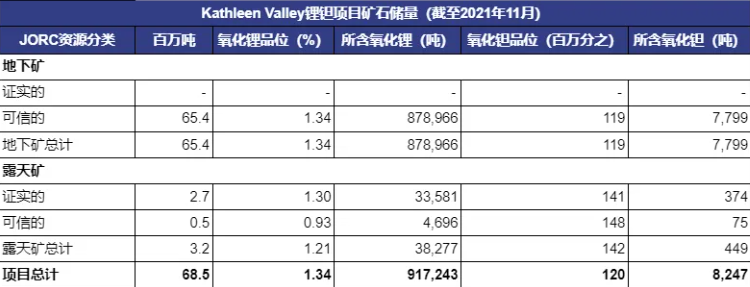
Kathleen Valley项目的初始产能为250万吨/年,可生产锂辉石精矿50万吨/年。项目还计划在第六年扩建至400万吨/年,届时锂辉石精矿产量可达70万吨/年。项目采矿活动将主要在地下进行,这有助于直接从高品位矿化中进行开采,同时最大限度地减少项目的浪费和环境足迹。该项目开采出的矿石将通过一个全套矿石浮选回路进行处理,预计在整个矿山服务年限内的回收率为78%,钽精矿的现场回收率为42%。
财务
公司季末手握现金45m,足够支撑较长时间。2021年十月公司以实物配售的方式完成了Minerals 260 Limited的合并,它本就是LTR的全资子公司,因此改合并项目并没有产生税务方面的问题,最主要的是剥离了Moora,Koojan JV,Dingo Rocks和Yalwest这一批非锂矿勘探项目,可谓更加专业和精细化。Mineral 260 Limited的拆分再并购公允价值为9096万,因此在财报中显示LTR本财年在没有锂矿产出的情况下有了超过40m的净利润。2022年6月,公司正式和福特签署了具有约束力的完整融资机制协议,完成了3亿澳元的债务融资。连同LTR于 2021 年 12 月筹集的 4.63 亿澳元,意味着它现在已经获得了项目所需资金的承诺,以支持项目全面发展直到实质性产出。
更详细的股评报告,请联系小助手获取。免责声明:GO Markets分析师或外部发言人提供的信息基于其独立分析或个人经验。所表达的观点或交易风格仅代表其个人;并不代表GO Markets的观点或立场。联系方式:墨尔本 03 8658 0603悉尼 02 9188 0418中国地区(中文) 400 120 8537中国地区(英文) +248 4 671 903作者:Xavier Zhang | GO Markets 专业分析师


热门话题
10月26日早盘时段,美元指数在110.90附近震荡,目前处于近三周以来的低点,因上周旧金山联储主席Mary Daly表示“美联储应避免加息过度而让美国经济陷入主动低迷,现在试试后开始讨论放慢加息速度了”。对加息过猛同样感到不安的还有美联储副主席布雷纳德以及芝加哥联储主席等人,他们更加支撑稳健而缓慢地提升利率。但是,美联储之内也不乏鹰派的声音,也有多个地方联储主席主张机遇目前通胀毫无进展的情况下应该延续激进的加息方案。
可见,不光是市场,美联储内部也有较大的分歧。市场在得知了美联储可能会放缓加息的可能性之后,美元指数连续两周下跌,不过目前仍在109.5-110支撑带之上,等待陆续公布的经济数据得以参考。
明天也就是周四,将会在23:30公布美国第三季度的GDP数据,目前市场的预测值教上一季度有所增长;周五将迎来另一个有关美国通胀的关键数据---PCE物价指数,也是在23:30 公布,PCE以及核心PCE的预测值都高于前值。
本周最后两天公布的数据将会极大的影响到下月初公布的美联储利率决议。如果GDP数据好于预期,并且PCE指数高于预期,那么大概率加息力度不会明显放缓,11月很有可能继续维持75个基点的力度,但若GDP数据大幅不及预期,那这一剂猛药是否敢用也要打个问号了。
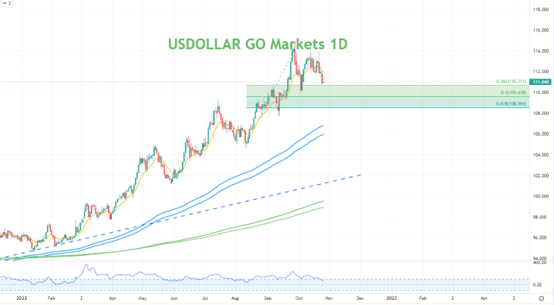
回到交易上,目前从日线级别,美元虽有回调,但仍处于上升通道长当中,即将触及0.382的斐波那契回调位置,对于思路清晰,止损坚定的交易者来说,这是一个值得考虑的进场位置,盈亏比划算,有事件推动(通胀数据不好的概率更大),以及利率决议即将来袭,无论是短线还是长线都有进场的理由。保守的止损看在前低的位置附近,更加激进一些的止损可以考虑0.5的斐波那契回调位之下。

当地时间10月24日,英国的执政党 保守党的党首竞选结果公布,前财政大臣苏纳克作为唯一一名候选人,自动当选英国首相,他是英国历史上首位亚裔首相,也是英国两个月以内的第三位首相。苏纳克出任首相后,镑美出现一定回暖,一方面是政策混乱的特拉斯不再执政,另一方面,作为前高盛分析师出任约翰逊政府财政大臣的苏纳克相对于特拉斯来说应该更懂得如何带领英国重振经济。但是对于一个政党来说,团结也是各类政策得以推行的重要因素,许多医院认为他对前首相约翰逊的下台负有责任,苏纳克被质疑是否能够将分裂的保守党团结在一起。
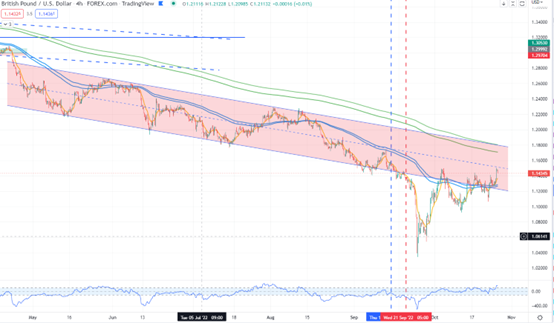
虽然目前英镑出现了阶段性反弹,但是鉴于美元的加息周期并没有结束以及欧洲各类风险事件的潜在威胁,镑美的反弹空间比较有限。目前4小时级别,上方阻力在1.1600-1.1700附近,并且任然处于下行通道当中。若美元继续强势,仍然可以考虑逢低做空的策略。
免责声明:GO Markets分析师或外部发言人提供的信息基于其独立分析或个人经验。所表达的观点或交易风格仅代表其个人;并不代表GO Markets的观点或立场。联系方式:墨尔本 03 8658 0603悉尼 02 9188 0418中国地区(中文) 400 120 8537中国地区(英文) +248 4 671 903作者:Rick Shao | GO Markets 专业分析师


The EURUSD is showing some signs of a potential short term break out on the daily and 4-hour time price charts. This is largely a technical breakout, although it is also supported by a shift in sentiment towards growth assets and away from the USD in the last week. Technical Analysis The daily cart shows a long term down trend with the price respecting the trend.
On the daily time frame, the price has broken through the trend line. In addition, the price has broken above the 50 period Exponential Moving Average. This represents a short-term support level and a good position for a trailing stop loss or hard stop loss.
Looking at the 4-hour chart provides a more direct profit target and entry trigger. The chart shows that the candle sticks are forming into what may become a flag. An entry based on the current price action may be triggered by a breakout of the flag past 1.000 which is also the parity level.
This level also presents as the neckline for a double bottom. This further indicates a potential bottom, or a reversal is about to take place. Using the 50-day Exponential moving average as the position for the stop loss at 0.9914, and the next resistance as a profit target at 1.0200 gives the trade yields a Risk Reward ratio of nearly 2.7.
With volatility surrounding the market being relatively high there is still risks with this trade and traders should be aware of potential macro factors that may impact on the trade.


The UK has had to deal with recessionary fears, sky high energy prices, a cost-of-living crisis, and a breakdown in political leadership. This has caused the GBP to fall to lows not seen since the last century. The British economy has also had to deal with a potential liquidity crisis caused by some of the large UK retirement funds almost bringing down the UK economy however with some support from the Bank of England the situation has in the short term been resolved.
The political pressures have also eased somewhat with Liz Truss stepping down and Rishi Sunak taking over the role of Prime Minister, which may further support the potential for a reversal and show o strength in the pound. With the price so beaten down at some stage it will have to turn around. The question is this reversal about to occur?
Technical Analysis On the weekly chart, the price has been ranging between 1.4369 and 1.1985. Earlier this year the price dropped below the bottom of the range for second time with the only other time being the initial stages of the pandemic. The lower bounds of the range present a potential target if the reversal is validated.
The price has finally started higher and the strength of the weekly candles and the volume supporting the price action indicates that supply is being depleted. The risk for a potential reversal is just how aggressive the long-term moving averages are to the sell side. Both the 50- and 200-week moving averages are still pushing to the downside.
The daily chart shows an interesting picture. The price of the pair is clearly coiling and almost ready to break out of its consolidation. If the price can break out it may provide a short-term target of 1.19853 may provide a potential price to take profit.
With volatility seemingly settling around the UK's economy, the potential for a reversal remains, which may only improve the prospects for the Pound.

